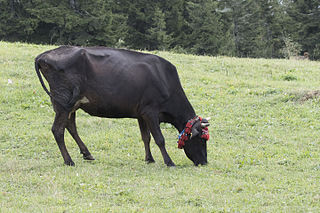 W
WThe Anatolian Black, also known as Native Black Cattle, is a breed of cattle that originated in Anatolia, in what is now Turkey. They are the most popular cattle breed in Turkey, and are used in dairy production, meat production, and as draught animals on small farms. They are primarily raised in central Turkey.
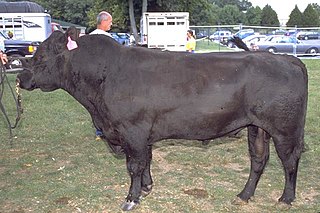 W
WThe Aberdeen Angus, sometimes simply Angus, is a Scottish breed of small beef cattle. It derives from cattle native to the counties of Aberdeenshire and Angus in north-eastern Scotland.
 W
WThe Arouquesa is a cattle breed from Portugal. The Arouquesa breed was granted protected geographical status of DOC from the European Commission
 W
WThe Bali cattle also known as Balinese cattle are a domesticated form of the Javan banteng. Bali cattle were an important source of meat and were used for plowing. Bali cattle are a domestic subspecies originated in Indonesia.
 W
WThe Blonde d'Aquitaine is a modern French breed of large domestic beef cattle. It was created in 1962 by merging three blonde draught breeds of south-western France, the Blonde des Pyrénées, the Blonde de Quercy and the Garonnaise. Since about 1970 it has been selectively bred specifically for beef production. It is the third-most numerous beef breed of France, after the Charolais and the Limousin. It has been exported to many countries round the world.
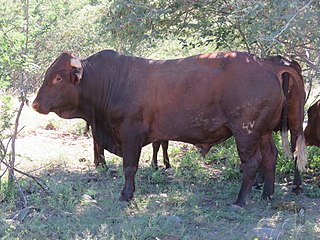 W
WThe Bonsmara is a breed of cattle known for its high quality beef and resistance to local diseases. Originating in South Africa as a scientific experiment of professor Jan Bonsma, the Bonsmara was created after many cross matings and back-crosses consisting of five-eighths Afrikaner (Sanga-type), three-sixteenths Hereford, and three-sixteenths Shorthorn.
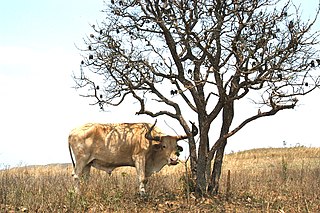 W
WCaracu is a Brazilian dual purpose cattle breed known for its adaptability, hardiness and excellent maternal ability. . Like the Mocho Nacional, the Caracu is a tropical European breed created in Brazil and its origin is of the race Minhota. Its main use is as a cross to beef cattle. The Caracu accounts for less than 5% of Brazilian beef cattle; the Nelore breed is by far the predominant breed in Brazil.
 W
WThe Frankeston Red is a genetically improved bovine cattle, its creation focus was for it to be a dual-purpose cattle to be used as both dairy and beef cattle.
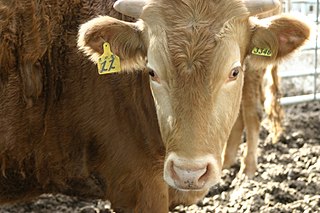 W
WThe Hanwoo, also Hanu or Korean Native, is a breed of small cattle native to Korea. It was formerly used as a draught animal, but this use has almost disappeared. It is now raised mainly for meat. It is one of four indigenous Korean breeds, the others being the Chikso, the Heugu and the Jeju Black.
 W
WThe Hereford is a British breed of beef cattle that originated in the county of Herefordshire, in the West Midlands of England. It has been exported to many countries, and there are more than five million purebred Hereford cattle in over fifty nations worldwide. The breed was first exported from the United Kingdom in 1817, initially to Kentucky, and spreading across the United States and Canada, through Mexico, to the great beef-raising countries of South America. Today, Hereford cattle dominate the world scene from Australasia to the Russian steppes. They can be found in Israel, Japan and throughout continental Europe and Scandinavia, in the temperate parts of Australia, Canada, the United States, Kazakhstan and Russia, in the centre and east of Argentina, in Uruguay, in Chile, and in New Zealand, where they make up the largest proportion of registered cattle. They are found all around Brazil and they are also found in some Southern African countries. They originally found great popularity among ranchers of the American Southwest, testament to the hardiness of the breed; while originating in cool, moist Britain, they have proven to thrive in much harsher climates on nearly every continent.
 W
WThe Japanese Black is a breed of Japanese beef cattle. It is one of six native Japanese cattle breeds, and one of the four Japanese breeds known as wagyū, the others being the Japanese Brown, the Japanese Polled and the Japanese Shorthorn. All wagyū cattle derive from cross-breeding in the early twentieth century of native Japanese cattle with imported stock, mostly from Europe. In the case of the Japanese Black, the foreign influence was from European breeds including Braunvieh, Shorthorn, Devon, Simmental, Ayrshire and Holstein.
 W
WThe Japanese Brown is a breed of small Japanese beef cattle. It is one of six native Japanese cattle breeds, and one of the four Japanese breeds known as wagyū, the others being the Japanese Black, the Japanese Polled and the Japanese Shorthorn. All wagyū cattle derive from cross-breeding in the early twentieth century of native Japanese cattle with imported stock, mostly from Europe. In the case of the Japanese Brown, the principal foreign influence was from the Korean Hanwoo and Swiss Simmental breeds.
 W
WThe Kuchinoshima is a critically-endangered Japanese breed of small feral cattle. It is found only on Kuchinoshima Island, in the Tokara Islands in Kagoshima Prefecture in southern Japan. It is one of six native Japanese cattle breeds, and one of two small populations that have never been cross-bred with Western cattle, the other being the Mishima breed from Mishima Island north-west of Hagi, in Yamaguchi Prefecture.
 W
WThe Limousin, French: Limousine, is a French breed of beef cattle from the Limousin and Marche regions of France. It was formerly used mainly as a draught animal, but in modern times is reared for beef. A herd book was established in France in 1886. With the mechanisation of agriculture in the twentieth century, numbers declined. In the 1960s there were still more than 250 000 head, but the future of the breed was not clear; it was proposed that it be merged with the other blonde draught breeds of south-western France – the Blonde des Pyrénées, the Blonde de Quercy and the Garonnaise – to form the new Blonde d'Aquitaine. Instead, a breeders' association was formed; new importance was given to extensive management, to performance recording and to exports. In the twenty-first century the Limousin is the second-most numerous beef breed in France after the Charolais. It is a world breed, raised in about eighty countries round the world, many of which have breed associations.
 W
WMadura cattle or Madurese cattle are a stable, inbred hybrid of Zebu and Banteng. They originated from the island of Madura just northeast of Java, in Indonesia where the original cattle population was the wild Banteng, very similar to Balinese cattle. Sinhala cattle, a Zebu breed from Sri Lanka, were introduced more than 1500 years ago, and the crossbreeds between the two was found to be better in body size than either of the original breeds. Some sources say the Zebu component was Ongole Cattle from India. The coloration is reddish brown with non-specific white patterning on the back and rump. They are a small breed, bulls having a mature weight of 250 to 300 kg, it is used for racing by the locals and are sometimes called the dancing cattle. In 2002 the population was estimated by the FAO at 900,000. Efforts are being made to conserve the breed on Sapudi island.
 W
WThe Mishima is a critically-endangered Japanese breed of beef cattle. It is found only on Mishima Island, some 50 km north-west of Hagi, in Yamaguchi Prefecture, Japan. It is one of six native Japanese cattle breeds, and one of two small populations that have never been cross-bred with Western cattle, the other being the Kuchinoshima breed from Kuchinoshima island in the Tokara Island group.
 W
WMurray Grey is a breed of Australian polled beef cattle that was developed in the upper Murray River valley on the New South Wales-Victoria border.
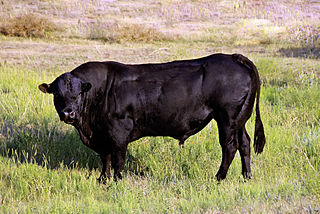 W
WNorth American Piedmontese cattle are a breed of domestic beef cattle originating from an imported herd of select Italian purebred Piedmontese cattle. The foundation line of breeding stock was first imported from Italy into Canada in 1979, and into the United States in the early 1980s. Piedmontese cattle are distinguished by a unique, naturally occurring gene identified as the myostatin allele mutation, or inactive myostatin gene. Myostatin prohibits muscle growth whereas an inactive gene has the opposite effect. Purebred Piedmontese are homozygous,, which means they have two identical alleles present for this unique gene. Research indicates the presence of the myostatin allele mutation produces morphological characteristics unique to the breed, such as double-muscling, beef tenderness, reduced fat content and high yield. According to the North American Piedmontese Association (NAPA), they are the first breed registry to base animal registration requirements on the presence of this specific gene which can be easily verified by DNA testing.
 W
WThe Piedmontese is a breed of domestic cattle that originated in the region of Piedmont, in north-west Italy. The calves are born fawn coloured, and turn grey-white as they mature. Piedmontese cattle carry a unique gene mutation identified as an inactive myostatin allele that causes hypertrophic muscle growth, or double muscling. Purebred Piedmontese cattle are homozygous, meaning they have two identical alleles present for this unique gene. They have garnered attention from breeders of beef cattle in other parts of the world, including North and South America. A small group of select Piedmontese bulls and cows were imported into Canada in the late 1970s, and into the United States in the early 1980s, and were used as the foundation breeding stock to develop a new breed of beef cattle known as North American Piedmontese cattle.
 W
WThe Red Poll is a dual-purpose breed of cattle developed in England in the latter half of the 19th century. The Red Poll is a cross of the Norfolk Red beef cattle and Suffolk Dun dairy cattle breeds.
 W
WThe Romosinuano is a breed of cattle native to Colombia. Its name derives from the fact that the breed is polled (romo) and that it originated from the Sinú River valley (sinuano). Romosinunao are a criollo type, developed from the horned Costeño con Cuernos breed of Spanish origin. It is unclear whether the polled nature of the Romosinuano was due to natural mutation or to cross-breeding with European types such as the Angus or Red Poll.
 W
WWagyu is any of the four Japanese breeds of beef cattle.